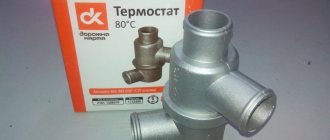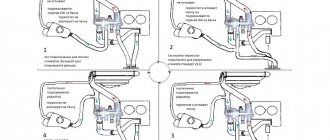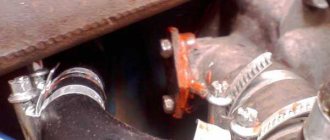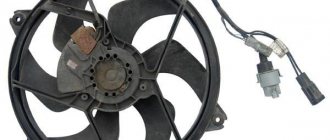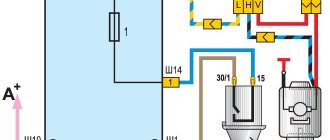The slightest violation of the thermal regime of a car engine can cause it to fail. The most dangerous factor for a power plant is overheating. Most often it occurs due to a malfunction of the thermostat - one of the main elements of the cooling system.
- Why do you need a thermostat?
- Design
- Operating principle
Video: how the thermostat works
- VAZ 2101 thermostat malfunctions and their symptoms
Why does the thermostat fail and is it possible to restore its functionality?
- What to do if the thermostat is stuck closed on the road
- Video: checking the thermostat
- Removing the thermostat
Video: replacing the thermostat
Purpose
It is needed to control the temperature of the coolant circulating through it. How he does it? – It opens, releasing antifreeze through a large circuit of the cooling system and, when the temperature drops to a certain value, it closes.
In the closed position, the coolant moves in a small circle, bypassing the radiator. So it starts to heat up. Having reached a value, for example, VAZ 2101, the opening temperature of the thermostat is 80 degrees - it opens. In this case, the liquid flows through the main radiator and is cooled. Then it closes. This process occurs repeatedly throughout the engine's operation. This maintains the optimal temperature regime of the vehicle’s internal combustion engine.
VAZ 2101 thermostat malfunctions and their symptoms
“Kopeykas,” like other representatives of classic VAZs, were equipped with domestically produced thermostats, produced under catalog number 2101–1306010. The same parts were installed on cars of the Niva family.
The thermostat is used to maintain optimal engine temperature
The thermostat is designed to maintain optimal engine thermal conditions. In essence, it is an automatic temperature regulator that allows you to quickly warm up a cold engine and cool it when it heats up to the limit value.
For the VAZ 2101 engine, the optimal temperature is considered to be in the range of 90–115 oC. Exceeding these values is fraught with overheating, which can cause the cylinder head gasket to burn out, followed by depressurization of the cooling system. Moreover, the engine may simply seize due to an increase in the size of the pistons caused by high temperatures.
If the cylinder head gasket is damaged, the cooling system depressurizes.
This, of course, will not happen with a cold engine, but it will not be able to operate stably until it warms up to the optimal temperature. All calculated characteristics of the power unit regarding power, compression ratio and torque directly depend on the thermal conditions. In other words, a cold engine is not able to produce the performance declared by the manufacturer.
Read more: Charging relay VAZ 2106: check and main malfunctions
Design
Structurally, the VAZ 2101 thermostat consists of three blocks:
- non-separable body with three pipes. It is made of metal that has good chemical resistance. It can be copper, brass or aluminum;
- thermocouple This is the main part of the device, which is located in the central part of the thermostat. The thermoelement consists of a metal body, made in the shape of a cylinder, and a piston. The internal space of the part is filled with special technical wax, which has the property of actively expanding when heated. Increasing in volume, this wax pushes a spring-loaded piston, which, in turn, actuates the valve mechanism;
- valve mechanism. It includes two valves: bypass and main. The first serves to ensure that the coolant has the opportunity to circulate through the thermostat when the engine is cold, bypassing the radiator, and the second opens the way for it to get there when heated to a certain temperature.
The bypass valve opens at low temperatures and allows coolant to pass directly into the engine, and the main valve opens when heated to a certain temperature, directing the liquid through a large circuit to the radiator
The internal structure of each unit is of only theoretical interest, because the thermostat is a non-separable part that can be changed entirely.
The thermostat consists of the following elements: 1 - inlet pipe (from the engine), 2 - bypass valve, 3 - bypass valve spring, 4 - glass, 5 - rubber insert, 6 - outlet pipe, 7 - main valve spring, 8 - main valve seat valve, 9 - main valve, 10 - holder, 11 - adjusting nut, 12 - piston, 13 - inlet pipe from the radiator, 14 - filler, 15 - holder, D - fluid inlet from the engine, R - fluid inlet from the radiator, N - liquid outlet to the pump
Operating principle
The VAZ 2101 engine cooling system is divided into two circles through which coolant can circulate: small and large. When starting a cold engine, liquid from the cooling jacket enters the thermostat, the main valve of which is closed. Passing through the bypass valve, it goes directly to the water pump (pump), and from it back to the engine.
Circulating in a small circle, the liquid does not have time to cool, but only heats up. When it reaches a temperature of 80–85 oC, the wax inside the thermoelement begins to melt, increasing in volume and pushing the piston. At the first stage, the piston only slightly opens the main valve and part of the coolant enters the large circle.
The degree of opening of the main valve depends on the coolant temperature
The main part of the liquid continues to circulate in a small circle, but when its temperature reaches 93–95 oC, the thermoelement piston leaves the housing as much as possible, completely opening the main valve. In this position, all the coolant moves in a large circle through the cooling radiator.
There can only be two breakdowns of a thermostat: mechanical damage, as a result of which the device body has lost its tightness, and jamming of the main valve. There is no point in considering the first malfunction, since it happens extremely rarely (as a result of an accident, inept repair, etc.). In addition, such a breakdown can be determined even by visual inspection.
Main valve jamming occurs much more often. Moreover, it can jam in both the open and closed or middle positions. In each of these cases, the signs of its failure will be different:
- The engine takes a very long time to warm up. According to the VAZ 2101 passport data, warming up the power plant to operating temperature should occur in 4–7 minutes, depending on the ambient temperature. If the motor does not settle within this time, most likely the main valve is “stuck” in the open position. In this case, from the moment the engine starts, the coolant passes in a large circle, that is, through the radiator, where its temperature decreases. To confirm or refute your suspicions, you need to start a cold engine, wait 1-2 minutes and touch the rubber hose connecting the thermostat and the upper radiator tank with your hand. If it is warm, the valve is definitely stuck in the open or middle position. It is possible to continue operating the car in such cases, but there is no guarantee that the valve will not move in the opposite direction and “stick”, blocking the flow of coolant to the radiator;
If the upper radiator hose becomes warm after 1-2 minutes of engine operation, the main thermostat valve is stuck open. - the engine warms up in less than 4 minutes, and then there is obvious overheating, confirmed by the readings of the coolant temperature sensor. In this case, the valve is jammed in the closed position. To confirm, let's turn to the same pipe running from the thermostat to the top of the radiator. If it remains cold after four minutes, the thermostat is faulty. You cannot continue driving with such a breakdown, otherwise the engine will fail;
- the temperature of the operating power unit is unstable. If the valve is stuck in an intermediate position, it is almost impossible to diagnose a malfunction of the thermostat without dismantling it. But if you notice that the needle on the temperature sensor constantly changes its position (even if the sensor and device are known to be working), the thermostat is probably the reason for this. Such a breakdown does not pose a serious threat to the engine, but it must be repaired as soon as possible.
Practice shows that even the most expensive branded thermostat lasts no more than four years. As for cheap analogues, problems with them can arise even after a month of use. The main causes of device breakdowns include:
- use of low-quality coolant;
- presence of oxidation products, water, dirt in the cooling system;
- manufacturing defects.
From personal experience, I can give an example of using cheap antifreeze, which I bought for some time on the car market in bulk from a “trusted” seller. Having discovered signs of the thermostat being stuck in the open position, I decided to replace it. Upon completion of the repair work, I brought the faulty part home to check and, if possible, bring it into working condition by boiling it in engine oil (why, I will tell you later).
When I examined the inner surface of the device, thoughts about using it ever again disappeared from me. The walls of the part were covered with multiple shells, indicating active oxidative processes. The thermostat, naturally, was thrown away, but the misadventures did not end there.
Read more: Audi a1 citycarver 2021: photo, price and characteristics of the new hatchback from Audi
After 2 months, there were signs of a broken cylinder head gasket and coolant entering the combustion chambers. But that's not all. When removing the head, cavities were found on the mating planes of the cylinder head, block, as well as on the windows of the cooling jacket channels. At the same time, a strong smell of ammonia emanated from the engine.
As a result, I had to buy a gasket, a block head, pay for its grinding, as well as all the dismantling and installation work. Since then, I have avoided the car market, buying only antifreeze, and not the cheapest one.
Poor quality coolant corrodes cooling system elements
Corrosion products and various debris most often cause the main valve to jam. They are deposited day after day on the inner walls of the case and at some point begin to interfere with its free movement. This is how “sticking” occurs.
As for marriage, it occurs quite often. Not a single car shop, not to mention sellers at the car market, will give a guarantee that the thermostat you purchased will open and close at the temperature indicated in the passport, and indeed work correctly. That's why ask for a receipt and don't throw away the packaging in case something goes wrong. Moreover, before installing a new part, do not be lazy to check it.
Deposits of dirt and oxidation products cause the main valve to jam
A few words about boiling the thermostat in oil. This method of repair has been practiced by our car owners for quite a long time. There is no guarantee that the device will work like new after such simple manipulations, but it’s worth a try. I conducted similar experiments twice, and in both cases everything worked out.
- motor oil (not used);
- a metal container that would hold the thermostat so that it is completely covered with oil;
- gas or electric stove;
- WD-40 aerosol or equivalent;
- carburetor cleaning fluid.
What does it consist of
- Frame. It is made of stainless steel
- Main valve - circulates coolant through the radiator
- Small circuit valve - its name speaks for itself
- Spring. Due to the elastic force, it returns the valves to their original position, closing them
- Cylinder with technical wax and rod. The rod pushes the valves, opening them
Electric fan
The fan is four-blade, made of plastic. The fan blades have a variable radius installation angle and, to reduce noise, a variable pitch along the hub. The fan is installed on the motor shaft and pressed with a nut. For better operating efficiency, the fan is located in a casing 18, which is bolted to the radiator brackets. The electric motor and fan assembly is mounted on three rubber bushings and secured with nuts to the studs of the fan casing 18.
The electric fan 19 is turned on and off automatically depending on the fluid temperature using a TM-108 type sensor installed in the lower radiator tank on the left side. The sensor contact closing temperature should be within 89-95°C, and opening temperature within 84-90°C.
In variant versions, VAZ-21061 vehicles can be equipped with fans mechanically driven from the hub of the coolant pump roller.
Cylinder with wax
It occupies an important place in the design. It contains wax, which expands when heated. There is a rubber coupling in the cylinder cavity, and the inner end of the rod is located inside. Its outer part is located outside the cylinder.
When wax is heated to a certain temperature, it expands. In domestic VAZ models it is 80 degrees. The coupling with the rod is squeezed out, resting against the body.
Springs
The design includes two springs. They help the valves “return” to their original position after the coolant has cooled, reliably isolating the two circulation circuits of the system from each other.
The thermostat itself is placed in a cylindrical housing with three pipes. Two are connected to different circulation circuits, the third to a water pump (pump).
Video showing how a thermostat works and is made:
Keep the temperature!
KEEP THE TEMPERATURE!
The thermostat is a simple device.
But very important. Errors when replacing it are unacceptable. The thermostat in the engine is used to maintain the proper temperature in the cooling system. But its functions are not limited to this: power, fuel consumption, exhaust emissions, and the efficiency of the heater all depend on a simple device. And also durability, engine life.
On all VAZ cars, the thermostat is removed from the engine block head and is an independent element. Today we know the following models:
2101 - all VAZ “classics” are equipped with these, starting with the first-born VAZ 2101. The valve begins to open at a temperature of 80±2°, and is fully open at 95±2°. A distinctive feature of the “first” thermostat is that the pipes are rotated relative to each other at an angle of slightly more than 90 degrees (photo 1 on the left).
2121 - for Niva. In terms of filling, the thermostat is practically “zero first”. Only due to the layout features, its pipes are located on the body at an angle of almost 180 degrees. By the way, the modernized Niva VAZ 21213 has a thermostat 2101.
2108 - the next generation of thermostats (photo 1 in the center) - intended for Samara engines. The latter have a more advanced combustion chamber shape and a higher compression ratio; their temperature regime is 7° higher than the classic ones. This improves the power and economic characteristics of the machine. The “eight” thermostat begins to open at 87°, and is fully open at 102°. True, today on the market there are “eighth” thermostats with a valve opening temperature of 85°. It’s easy to explain: the quality of thermostats today is not up to par; the valve often opens with a delay, creating a risk of engine overheating. So they dropped two degrees. "in reserve."
Thermostat 2108 pipes are located almost like at “zero first”, but seem to be mirrored in relation to it. In addition, closer to the bottom, the “eighth” has an additional thin pipe for connection to the expansion tank (see photo 1 in the center). This is the path for air bubbles to exit the cooling system if they somehow get there.
2110 - structurally repeats the “eight”, it has almost the same characteristics (circulation in the “large circle” will begin at 87 or 85°). Externally, it is even more similar (but also a mirror image, do not confuse it!) with “zero first”, since it does not have an additional thin pipe (photo 1, right).
On the VAZ 2110, the “road” for air was paved from the tee adjacent to the thermostat. The latter is intended for cars with carburetor engines (VAZ 2110 and 21111). If necessary, you can also install a “figure eight” thermostat on them, you just need to thoroughly plug its air pipe.
It happens that manufacturers of these products arbitrarily simplify the design, so when buying a thermostat, look into it. At the top of the housing there should be a vertical strip of metal or plastic, resembling a curtain, which covers the additional valve in a sector of approximately 270° (photo 2). Without this curtain, the liquid mixes less well, heats the thermoelectric element less and more slowly - and the thermostat switches to the “large circle” with a delay at elevated temperatures.
2112 - next generation thermostat - for injection engines (photo 3). It differs from the previous ones in that, in addition to the main function, it also increases the efficiency of the heater. For this purpose, the resistance of the “small circle” was increased, thereby forcing the coolant to flow more intensively through the heater radiator. This thermostat has a throttle hole in the inlet pipe. The transition from “small” to “large circle” begins at a temperature of 85°. By the way, the temperature threshold for the start of operation of any thermostat is squeezed out on the bottom (photo 4).
Let's now move on to the sensor (photo 5) for turning on the electric fan of the cooling system. Today, two generations of sensors are produced - two-amp and twenty-amp. Moreover, each, in turn, is divided into two categories - for classics and for front-wheel drive models.
The first generation includes veteran sensors TM-108. Since they could not directly switch large currents, this role was assigned to a special power relay, triggered by a command from the sensor. For classics, this sensor had an index of 2103–3808800. Let's remember: the “treshka” was the first VAZ car without a constantly rotating mechanical impeller. Fan switch-on temperature is 92°, switch-off temperature is 87°.
As already noted, the Samara engine has a more severe temperature regime. Therefore, here the electric fan turns on at a higher temperature than the classic one. The sensor contacts (2108–3828010) close at 99° and open at 94°.
New generation sensors do not need the help of a power relay - they are able to switch current up to 20 A themselves. Their response temperatures remain the same, and the indices are 661.3710 (for classics, catalog number 2110-3828010-10) and 66.3710 (for Samara and "ten" with engines 21083, number 2110–3828010). At the same time, on all models “ten”, “Samar” and “Lada” the use of a new fuse block is provided - a European type.
They can be distinguished by the numbers stamped on the edges of the hex key. On new generation sensors the first digits of the marking are stamped: “661” (for classics) or “66” (for “samara” and “ten”), on old ones - TM-108. In any option, the response temperature must be indicated on the adjacent plane.
New sensors can be painlessly installed in place of old ones. On the contrary - under no circumstances! The “one hundred and eighth” contacts will simply burn out if they cannot withstand the high current. In a hypothetical situation - the sensor has failed, and only TM-108 is at hand - you will have to change the electric fan switching circuit by introducing a power relay into it.
As for injection engines (VAZ 2111 and VAZ 2112), their electric cooling system fan is controlled by a controller (“injection brains”). The latter measures the coolant temperature with one of its special sensors. Therefore, in the radiators of the cooling systems of these machines there is no sensor for turning on the electric fan.
PS When the number was being typed up, we were informed that changes were being made to the design of thermostat 2112. The inlet pipe will now have not one throttle hole in the center, but four, arranged in a cross, closer to the walls. In this case, when the valve is open, the liquid washes the thermal power element more reliably.
Thermostat operating principle
It is the same for all models, both for the domestic automobile industry and foreign-made cars. The difference is in the opening temperature of the thermostat and design features. For example, there are electric ones, where the opening temperature is regulated by a special heating element. Now we will talk only about mechanical ones installed in most cars.
In the initial position, the valve of the large circle is closed, only the small one is open. Coolant flows from the cylinder block into the housing. Through an open valve, it circulates along a small circuit - from the cylinder block and engine head, passes through the thermostat, pump and returns back to the engine.
When the opening temperature reaches 80 degrees, the wax in the cylinder expands. Squeezes out the movable rod, which rests against the body. Further heating of the antifreeze leads to a greater output of the rod from the cylinder. Since it has already rested against the body, it has nowhere else to move out; it pushes the cylinder itself in the opposite direction.
Remember, there are two valves attached to the wax cylinder. They begin to move with him. At the same time, the valve of the large circle opens slightly, and the small one closes. Circulation begins through two cooling circuits.
With a further increase in temperature, the rod extends to its full length. Which leads to the complete closure of the small circle valve and the opening of the large one. In this case, all the liquid “flows” through the radiator and returns to the engine.
The liquid cools, the wax contracts, and the rod is partially immersed deep into the cylinder. Due to the return springs, the valves try to return to their original position.
Replacing the thermostat on a VAZ 2101-VAZ 2107
The thermostat on a VAZ 2107 car is a mechanism by which the coolant temperature is maintained within certain limits.
If the thermostat on a VAZ 2107 fails, this leads to increased fuel consumption, reduced engine life, or even jamming. At the slightest sign of malfunction, it will need to be replaced with a VAZ 2107.
In the material we will consider in detail what this device is, why it is needed, and how to replace it.
The thermostat is located between the large and small circles of the engine cooling system. Structurally, the product has the form of a housing, inside of which there is a valve with a temperature-sensitive element. This valve switches the coolant flow in a small or large circle.
The coolant flow regulator is connected through pipes to the pump, engine and cooling radiator. At the moment the engine starts, when the antifreeze has not yet warmed up, the thermostat, or rather its valve, is in closed mode.
The coolant circulates through a pump and passes only through the cylinder block.
The liquid that is in the radiator does not take part in the cooling process of the engine, but until it heats up to 80-90 degrees.
It is important to know! The thermostat valve on the VAZ 2107 opens completely when the coolant temperature reaches 84-86 degrees.
When the set temperature is reached, the thermostat locking disc moves. As a result of the valve opening, liquid begins to circulate in a large circle, passing through the radiator.
When fluid circulates through the radiator, the cooling efficiency of the engine increases. As soon as the temperature of the liquid decreases, the valve closes and circulation occurs in a small circle.
The coolant temperature indicators are affected by the following indicators:
- motor operating mode;
- movement speed;
- outside air temperature.
The thermostat maintains the coolant in a certain temperature range. This, in turn, affects the functioning of the motor, for which constant temperature indicators are important.
In terms of design, all types of thermostats on the VAZ-2107 are practically no different. Structurally, they are a housing with a thermal valve located inside.
The design of the device has three holes that serve to connect hoses from the cooling system.
Such a simple mechanism as a thermostat has only three causes of possible malfunctions:
- The valve does not close, as a result of which the liquid constantly circulates in a small circle without passing through the radiator.
- The valve does not open completely, which reduces the cooling efficiency of the motor.
- The valve does not close. In this case, the antifreeze passes in a large circle through the radiator. This has a negative impact on the engine, as it does not reach the required operating temperature.
Before replacing a product, you need to make sure it is not working. Let's find out in more detail how to check the thermostat of a VAZ 2107. You can determine one of the above malfunctions in the following ways:
- If the valve is jammed and does not close, then after starting the engine you need to check whether the lower part of the radiator immediately heats up or not. If it happens right away, this indicates that the device is faulty.
- If the device is jammed and does not open, then the engine temperature will rise, which can lead to costly repairs.
- Valve wedging can be detected by the fact that the motor does not reach sufficient temperature for a long time.
Such procedures can be performed at home. You can buy a new thermostat and install it in place of the old one, thereby checking its performance.
Another reason for product failure is water poured into the system. If the water is frozen in the system, it is prohibited to start the engine.
To replace the thermostat on a VAZ 2107, or it is also called a thermostat, you will need to use a screwdriver. The replacement principle is as follows:
- Wait for the engine to cool down.
- Drain antifreeze from the system.
- Initially, use a wrench or screwdriver to loosen the fastening of the clamp connected to the radiator. Disconnect the hose. Loosen and disconnect the fastenings of the two remaining hoses (from the cylinder block and pump).
- Dismantle the device along with the hoses.
- Replace the product along with the hoses if necessary. If the hoses have obvious defects, it is recommended to replace them immediately.
- Put on new hoses, then install the thermostat in place and tighten the clamps well.
- Now you can fill the system up to the mark and close the radiator cap. After starting the engine, the fluid level will drop, so you will need to add antifreeze.
Finally, you need to check the quality of operation of the device.
What is the best thermostat to install on a VAZ 2107? Under the “seven” you can install a thermostat from a VAZ 2110 car, which is practically no different. But there is still a difference: such a sensor allows the coolant temperature to rise to 95 degrees. Sellers advise: “Install a temperature regulator from “ten”, and you won’t have any problems!”
After we finalize the thermostat, we will need to check and configure it.
Welcome! A thermostat is a thing thanks to which the engine can warm up very quickly, or for a very long time if the thermostat is removed from the cooling system (And this can be done by inserting instead a regular housing from a similar piece of hardware and connecting all three main pipes to it cooling system) then the liquid will immediately begin to run in a large circle, in the summer this is good, because the car will not really warm up, especially in traffic jams, but as soon as winter comes, such a problem that the car does not really warm up begins to manifest itself strongly, excess fuel consumption due to with this it appears (you have to warm up the car longer), more heavy loads are placed on the engine, since engines are not designed to operate for a long time in a cooled state, because of this, only troubles occur and it seems like such a small thing, but it can create so many problems your car and therefore, as soon as problems with cooling begin, we recommend immediately changing the thermostat and under no circumstances delay replacing it.
Note! To replace a thermostat in a classic, you will need a minimum set of tools, namely: A screwdriver (Although this also depends on how you attach the clamps to the connecting pipes; if they are bolted, then you will need a wrench, so take this into account right away) and a container in which you will have to drain the coolant (Without draining the coolant, it is not possible to replace the thermostat, it will have to be drained partially and therefore not all of it will pour out of the cooling system, but still buy 5 liters from the auto store of exactly the same liquid that is poured into the engine of your car, have to!
Tell me what model of box is shown in this video???
Read more: VAZ 2107 clutch device operating principle adjustment replacement and repair
I have an Aveo T 250 1.6, through the diagnostic obd, I can see how the temperature rises to 55′ in 3 minutes from 20′ and it doesn’t switch to gas... although the temperature on the LPG is set to 40′! What could it be?
I like you for the test, but bro, in the summer, on the contrary, you need to be brighter or yellower! Wet asphalt, all that.. and in the winter, even cheap ones will cost a hundred dollars) it will still turn up the snowball brightness!
- Guiana
- iPad has already learned to write Full HD?
- Deeann
and chasing the hurricane of last year, no? They would post the full versions.
- Famin
- Just watch out for rust on this beautiful beastie, will probably be less of a problem in your hot climate though
